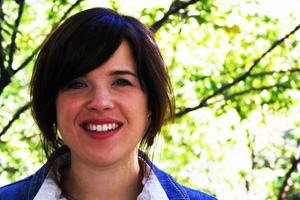In her new book, Melanie Jean Springer, UC Santa Cruz assistant professor of politics, examines voter turnout in the United States, one of the lowest in any developed democracy, and reform efforts to improve it.
In How the States Shaped the Nation: American Electoral Institutions and Voter Turnout 1920-2000 (University of Chicago Press, 2014) she finds that states that try to boost turnout with convenience-voting methods such as motor-voter laws, generous absentee ballot rules, and longer polling times are far less successful than states that try to suppress turnout.
Though the poll taxes and literacy tests that southern (and some non-southern) states once used to quash the minority vote have been outlawed, other efforts such as voter ID laws and the reduction of polling places in certain neighborhoods have taken their place.
"People tend to think once we got away from poll taxes and voter registration suppression everything was good," said Springer, who joined the UCSC politics department last fall after seven years at Washington University in St. Louis. "One of my most persistent findings is when states try to restrict voter turnout they are quite effective (more so than when they try to make voting processes easier)," she said. "We should be alarmed."
U.S. federalism allows the states to control how voting will take place. States have had—and continue to have—sizable local effects, she says. "By design, this system fosters variability while also allowing, and perhaps even creating, instances of inequality," Springer writes in the book’s introduction that discusses the 2000 presidential election and Florida, with its butterfly ballots and hanging chads, the final result ultimately decided by the U.S. Supreme Court after more than a month of court battles.
"The heightened awareness of state power over electoral procedures following the Bush vs. Gore election initiated widespread criticism of the American electoral system, and spurred countless calls for national electoral reform," Springer writes.
Although reformers often assume that more convenient voting procedures will produce equivalent effects wherever they are implemented, she reveals that this is not the case. In fact, convenience-voting methods have had almost no effect in the southern states where turnout rates are lowest.
Springer focuses her analysis on the 80 years between 1920 and 2000, the period following the Progressive era up through the Bush-Gore election.
Ultimately, Springer argues, no single institutional fix will uniformly resolve problems of low or unequal participation. If we want to reliably increase national voter turnout rates, we must explore how states’ voting histories differ, and better understand the role of political and geographical context in shaping institutional effects, she says.
Springer earned her B.A. at UC San Diego in political science and history, and her Ph.D. in political science at Columbia University. She is teaching two classes this spring and in the fall, American Elections and Voting Behavior and Society and Democracy in American Political Development.
New book examines states' influence on national voter turnout
Professor finds state action is more effective in suppressing participation than boosting it




